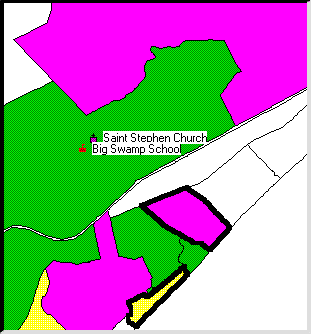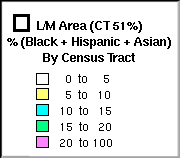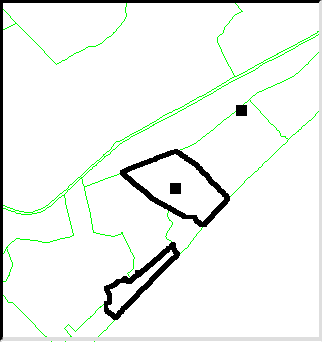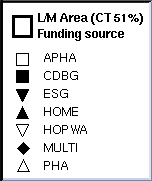

Myrtle Beach, South Carolina, copes with the kind of radical seasonal swings that characterize most resort cities. When summer vacationers swarm to its seashore attractions, business peaks at hotels, restaurants, shops, and entertainment centers. Tourists generate jobs for permanent residents, long-distance commuting service workers, and the cadre of students who annually combine modest earnings with access to sand and surf. However, these wage earners must compete on an unlevel playing field with vacationers and a colony of retirees -- all bidding for the scarce housing and other resources -- in a market geared to the incomes of those two more affluent groups. Myrtle Beach's Consolidated Plan is designed to broaden housing opportunities for a range of disadvantaged residents and to reverse the decline of a single targeted neighborhood by acting in conjunction with neighborhood leaders to stimulate community development there.
Myrtle Beach took a two-pronged approach to citizen participation. It conducted two separate planning activities, which were later merged during public hearings preceding the city council adoption of the Consolidated Plan. On one track, planners involved representatives of 25 organizations as they began to prepare the housing plan, interviewing each in person or by phone. These representatives were then sent draft sections of the plan pertinent to their organization's activities. Followup interviews were conducted as planning proceeded. Discussions related to the special needs of children were held with four relevant groups. The city's communication regarding nonhousing community development has been largely through committees representing residents in the Booker T. Washington neighborhood, the Neighborhood Revitalization Strategy area. Advertisements were placed in newspapers in advance of public hearings. Responses were made to residents who expressed concern at two public hearings that preceded formal adoption of the plan by the city council.
Myrtle Beach, with a 1990 population of 24,848, is the hub of a linear metropolitan community that hugs the 50-mile coastline, called the Grand Strand, which extends from Wilmington, North Carolina, to Georgetown, South Carolina. Summer swells the population of the Grand Strand to an estimated daily peak of 500,000. Historically, Myrtle Beach has been North and South Carolina's regional summer vacation resort.
By the mid-1960s, Myrtle Beach was attracting vacationers from throughout the eastern United States and Canada and was a magnet for retirees, particularly those from northern communities. While blessed with seashore amenities, the city has a service-oriented economy. Jobs tend to be seasonal, low-paying, and mostly devoid of benefits.
Median family income (MFI) in Myrtle Beach is $29,403. Citywide, 10.5 percent of the population lives in poverty. Forty-nine percent have incomes below 80 percent of MFI.
The city's African-American population (14 percent) is concentrated in low- and moderate-income neighborhoods near the city's center. Approximately 30 percent of the African-American population lives in poverty.




Local housing market experts sharply contradict the 27-percent vacancy rate reported by the 1990 census (taken in April), which classified as vacant 9,603 of the 13,327 year-round housing units in Myrtle Beach. Local housing-industry observers calculate the actual vacancy rate to be about 5 percent, suggesting that census enumerators failed to distinguish many seasonally occupied housing units from year-round units.
Even if there were a measurable oversupply of housing in 1990, it could have resulted from the spate of development that occurred in the early 1980s. Now, more than 60 months have passed -- much of that time marked by low interest rates. Both the purchase and rental housing markets have tightened significantly, and several large rental managers report vacancy rates of about 1 percent.
Not contested are census figures showing that more than half (5,120) of occupied year-round units were rented, while 4,483 were owner-occupied. The ratio differs from what was found for Horry County, the State, and the Nation, in which more than half the units were owner-occupied.
In a windshield survey of the city, building code inspectors found 428 substandard units, just over half in multifamily buildings. Of those, 203 were classified as suitable for rehabilitation.
Housing problems in Myrtle Beach are concentrated among extremely low-income households (under 30 percent of MFI of $29,403), low-income households (31-50 percent of MFI), moderate-income households (51-80 percent of MFI), and middle-income families (81-95 percent of MFI). About 52 percent of households are renters. An analysis of rental patterns in Myrtle Beach suggests that a demand for homeownership is not being met. Need for greater opportunities for first-time homebuyers has also been expressed in public hearings.
Relocation to Myrtle Beach of retirees, promoted by the city and State, is expected to continue. Most of these buyers can afford housing prices in Myrtle Beach without assistance. However, as this group ages and mobility decreases, the need for adapting housing to accommodate people with physical disabilities may increase.
The 829 very low-income households (under 30 percent of which are at risk of homelessness) are households that spend more than 50 percent of their income on housing costs. A total of 1,016 households in the low-, moderate-, and middle-income categories have this housing problem.
In general, however, the population threatened with homelessness consists of low-paid workers in the city's tourist-oriented service sector. This population may become less threatened as the current round of tourist-related development continues. The largest new facilities are geared toward a year-round season. Many of them are affiliates of national companies that could increase competition and therefore boost wages and benefits for workers.
By several calculations, the Myrtle Beach Metropolitan Statistical Area (Horry County) is better off housing-wise than the majority of 183 other MSAs in the country. The median price of a home in the area is $80,000, well below the national median of $114,000. The median income family in Myrtle Beach could afford 62.7 percent of all homes sold.
As in other aspects of community life, the resort-oriented characteristics of the city constrain the housing market. Many rental properties (far more than the 1,405 seasonal units counted in the census) are priced to tap the more lucrative market of short-term vacationers, putting many of the units beyond the reach of permanent residents with modest incomes. Home sales follow the same pattern; relatively affluent retirees moving to Myrtle Beach can afford more expensive homes than local workers. Thus the overall supply of housing for the permanent, working population is reduced.
Proximity to the ocean drives land prices up in this long, narrow community, where most developable land is within a mile of the shore. Zoning regulations permit densities from 8 to 28 units per acre, which could spread the high cost of land among many units. Unfortunately, developers have not taken advantage of these permissive densities on the assumption that there is no market for such a residential pattern.
Census statistics, data gathered by the city and the real estate industry, and abundant anecdotal evidence indicate that there is a great need for affordable housing in Myrtle Beach.
It is estimated that there are at least 330 homeless people in the city at any one time. Needs of this shifting population vary, depending on family status, age, the causes of homelessness (such as fleeing domestic violence, severe mental illness, drug and alcohol addiction, illness such as AIDS), and whether they are living in shelters or on the streets.
With a $1.3 million grant awarded in 1992 under the Public Housing Scattered Sites program, the Myrtle Beach Housing Authority acquired 18 houses for rehabilitation, its total housing stock. All of those houses have been renovated and are now occupied by families.
Myrtle Beach has been allocated 348 Section 8, tenant-based certificates and vouchers. The number of certificates and vouchers received has been reduced drastically since 1991; therefore, demand for these vouchers and certificates has been heavy. The city closed its waiting list in May, 1994, when the total number of applicants reached 450. When the city reopened the waiting list in October, 1994, 57 applied the first day.
More than 250 housing units with below-market rents were built in Myrtle Beach under two Federal programs that are no longer active. A developer provided 136 units under the Section 8 new construction program in the Booker T. Washington neighborhood. Through Section 236 assistance, 131 units were built in an area known as Dogwood Forest.
Habitat for Humanity has built three houses in the city. All are occupied by residents who provided sweat equity and met income requirements for no-interest loans. Habitat plans to build five more homes. In keeping with its goal of stretching dollars to house as many people as possible, the group will give preference to large families. Habitat is an organization whose volunteers contribute both dollars and building skills to its projects.
A recent market survey showed that there would be a market in the Myrtle Beach area for 117 units of low-income housing tax credit (LIHTC) housing and 70 units for persons qualified under the HOME program. Elderly persons earning between $9,000 and $15,600 are eligible for LIHTC housing; elderly persons earning no more than $13,000 are eligible for the HOME program.
As noted, Myrtle Beach permits affordable densities. However, the highest density districts in the city could be more closely coordinated with a comprehensively planned transportation system. Zoning regulations and district locations could be revised to allow mixed uses in areas that would support public transportation and reduce dependence on private automobiles, reducing both traffic congestion and automobile costs for families.
The Planning Commission is studying provisions of its cluster development conditional uses on Planned Unit Development (PUD) district to clarify regulations and make them consistent with other city land-use policies. Confusion about the PUD has resulted in cluster developments that have not satisfied the commission.
Accessory apartments, not presently allowed in traditional single-family detached zoning districts, might make a family's principal unit less costly to own, encouraging young families to become first-time homeowners and helping elderly households to maintain independent living.
Developers complain that impact fees for water and sewer installation in new areas needlessly add to the cost of low- and moderate-income housing. Provisions in bonding agreements prevent the city from waiving such funds for affordable housing, but it might be possible to draw from some public funding source to mitigate those fees on developments with assisted housing.
The Horry County Community Housing Resource Board is responsible for fair housing issues. The Board, comprised of government, business, and religious representatives, reviews housing practices to ensure equal access to housing and to see that opportunities exist for representation of minorities in the real estate profession.
The Horry County Health Department conducts tests for and abates, if possible, lead-based paint hazards in Myrtle Beach. Few lead-based hazards have been reported to health officials, and none of the 9 to 15 reported instances of such poisoning during the past 5 years have had serious consequences or have been linked to lead-based paint.
In the southern half of Myrtle Beach that is eligible for Community Development Block Grants, the city has identified community development needs totaling $127 million, including public facilities, infrastructure, public services, accessibility modifications, historic preservation, and economic development. The city's 5-year capital improvements program is expected to supply approximately $20 million of the estimated $127 million needed to provide these facilities and services.
The Booker T. Washington neighborhood, the area designated as the target of the neighborhood revitalization strategy, is the area of greatest need. A special study found this area -- the city's historic black residential area -- is in need of better infrastructure, increased community services, improved housing, and greater employment and educational opportunities. Problems include poor storm water drainage, abandoned structures, and vacant lots.
The Consolidated Plan will be administered by the city's Community Development Office, working in conjunction with other divisions of the Planning Department, the Housing Authority, and a range of public and private entities.
The city intends to link its 5-year strategy for housing improvement to a neighborhood revitalization strategy in its most deprived area. The housing strategy establishes three areas of priority -- highest, medium, and low. This neighborhood revitalization seeks to concentrate sufficient public resources into this area to generate new private investment in housing and small business creation and to sustain city government interest in, and support for, the neighborhood.
Five classifications are accorded the highest housing priority, with housing opportunities for first-time homebuyers with children deemed to be the most critical. The high ratio of renters to owners in the moderate-income group suggests that there are households that would become homebuyers with some assistance. The city's goal is to build additional for-purchase housing units in its Futrell Park Homes project to supplement six units completed there earlier.
The next highest priority is assigned to elderly one- and two-member renter households. This group of 580 persons makes up 24 percent of all very low-income renter households. Two-thirds of these households have low or moderate incomes. The city is hoping to secure a HOME program grant to rehabilitate an unused school building in Futrell Park for 34 apartments for the elderly, and expects to provide general fund dollars for land acquisition and installation of utilities.
Large-family renter households are assigned third priority. Of the very low-income, large-family households, almost all (90 percent) are experiencing housing problems. Those in this category would be the chief beneficiaries of scattered-site housing now under construction.
Homeless individuals and families claim fourth priority. Several agencies have expressed the need for transitional housing for this group. The Housing Authority has submitted an application for a grant from HUD's Continuum of Care Program that would make 43 additional certificates or vouchers available for permanent housing for persons or groups who complete transitional residency.
Small-family renter households, the final priority classification, would receive consideration if additional Section 8 vouchers and certificates are awarded.
A formal neighborhood association, established as a nonprofit corporation, is expected to continue to marshal needed political support to the neighborhood revitalization strategy area. Private investment in this area is a real possibility. Within walking distance of the neighborhood is the city's downtown area and a new entertainment and retail development called Broadway at the Beach. Economic development is occurring at this complex. If funds are forthcoming from five public and private sources, including city funds and a CDBG loan and grant fund, investments in the area would total about $7.7 million.
Myrtle Beach is in the process of developing an antipoverty strategy. The existing Downtown Redevelopment Commission and a commission to facilitate reuse of the closed Myrtle Beach Air Force Base are expected to play major roles in carrying out this strategy.
Working arrangements to carry out the Consolidated Plan have been established by the Myrtle Beach City Manager's Office with the Housing Authority, the Planning Department, and the Community Development Office. Administrators of these city agencies will coordinate their activities with those of nonprofit Grand Strand Housing, Inc., and the Booker T. Washington Neighborhood Association for implementing the revitalization strategy. Meetings are held regularly to discuss project implementation issues.


Two activities will be the focus of the housing implementation strategy for the first year of the plan (July 1, 1995, through June 30, 1996). The first is a continuation of efforts to complete for-purchase housing, Futrell Park Homes. Six units are being completed and six more are under construction. The city will sell these units and return the proceeds to a revolving loan fund. The city also has obtained $350,000 through the South Carolina Housing and Finance Authority to assist in this project along with commitments of other second mortgage financing.
In the second project, the old 10th Avenue School buildings will be converted into 34 rental housing units for the elderly by a private developer. Funding for this project will involve CDBG, HOME, city and State Housing Authority funds, plus Federal tax credits and private investments.
With 1995-96 CDBG funds totaling $295,000 plus a HUD/CDBG Section 108 loan of $1,475,000, the city will make infrastructure improvements in the Neighborhood Revitalization Strategy Area. These improvements include street and storm drainage work such as the piping of a major neighborhood drainage ditch, the addition of a storm drainage retention pond, and paving four major streets with installations of curbs and gutters.
Agencies included in management of these first-year projects are the Planning Department's Community Development Office, the Housing Authority of Myrtle Beach, and other public and private housing providers in the community, including Grand Strand Housing, Inc., a nonprofit corporation established by the city and the Housing Authority. Educational programs on money management and budgeting for moderate-income homebuyers will be provided through organizations such as Habitat for Humanity.
Goals of the Futrell Homes Park for-purchase project are to provide at least six additional three- and/or four-bedroom dwelling units, each valued at $65,000, for first-time homeowners with children.
Rehabilitation of two buildings at the site of the old 10th Street School will provide at least 34, and possibly 48, rental housing units for the elderly.
The Housing Authority proposes to apply for 5 to 10 units of additional rental housing through its scattered-site public housing program at an estimated cost of $395,000. The authority also will apply for Section 8 vouchers or certificates valued at $300,000 and has applied for 43 additional certificates or vouchers for permanent housing under the Continuum of Care Program to assist formerly homeless families.